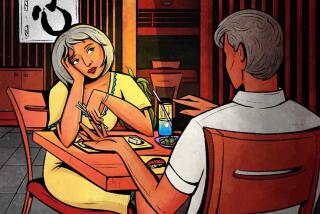Clearing Up a Soap Opera in Castile
- Share via
In reviewing my two errors of 1987, I overlooked a letter from Peter Davis, of Marina del Rey, noting my error in reporting that Princess Isabel of Castile and Prince Fernando of Aragon had been married in the Alcazar at Segovia.
That’s what the guide we hired for 300 pesetas told us. I would merely concede the error and make nothing further of it, but Davis’ story of the place and circumstances of the wedding is too pretty to leave untold.
It is true, Davis says, that Isabel (in English, Isabella) was crowned queen in Segovia in 1474, but it was in 1469, in Valladolid, to the north, that “Isabel, then 18, penniless and without resources, met and married Fernando (Ferdinand), then 17.”
Davis has made many trips to the Iberian peninsula in the past 10 years in search of material for a book he is writing on Isabel and Columbus, whose fateful voyage to the New World she authorized.
Isabel and Fernando were married “in perilous times,” he reminds us. “The kingdom of Castile and Leon was torn by wars, plots and rebellions, where every man’s hand seemed to be set against his neighbor’s, where old feuds were constantly rekindled and new ones flamed into pillage and rape, leaving the already bleak, rolling plains of Old Castile in gray ashes.”
Isabel’s half-brother, Enrique IV, opposed the marriage. He dispatched an army to seize her. She fled to Valladolid. Davis characterizes Enrique as “corrupt and profligate,” and charges that under his reign Castile had fallen to its lowest ebb.
Davis went to Valladolid to find the place where Isabel and Fernando were married. Isabel was staying in the palace of Juan de Vivero, a rich merchant. She had almost given up hope of meeting Fernando, when one night her protector, Don Alonso Carrillo, archbishop of Toledo, galloped up in his finest suit of armor and pounded on the great oak door with the hilt of his sword. “Following him was what looked like a group of ill-dressed merchants. But as they dismounted someone recognized Prince Fernando and called in the Castilian of the day, ‘ Ese es ! Ese es ! That is he!’ ” Although Isabel had never seen Fernando before, Davis insists it was “love at first sight.” Wasting no time, for political expediency, the archbishop married them the next day.
I don’t know how Davis could look into Isabel’s heart and conclude that it was “love at first sight,” but indeed it was a fruitful marriage; as “the two kings” they united Spain, ended the Muslim occupation, and sponsored the discovery and colonizing of the Americas.
Davis was dismayed to find that today the palace of Juan de Vivero stands almost in ruins, stark against the modern buildings of the University of Valladolid hospital. “It is being slowly restored, but few contemporary Spaniards seem to care. I hailed a quartet of passing students. ‘Is this the palace of Juan de Vivero?’ I asked in Castilian. ‘Where Isabel and Fernando were married?’ ”
“‘No se. No sabemos,’ was their only reply, shrugging their shoulders and dashing on.”
As long as I’m coming clean, I might as well admit one more error in my reports on Spain. Quoting from some pamphlet, I wrote that Walt Disney had modeled Disneyland’s Sleeping Beauty palace on the Alcazar at Segovia. Actually, I saw little resemblance between the two, but, when traveling, one believes the guidebooks.
I was straightened out by a letter from Elizabeth B. Clement of La Crescenta. “You mention the Alcazar as being the model for the Sleeping Beauty castle at Disneyland,” she wrote. “Catch me if I’m wrong but I believe that Neuschwanstein in Bavaria, built by King Ludwig II, is the model for the castle at Disneyland.”
Now that rings a bell. When my wife and I were in Bavaria a couple of years ago, I sat on a bench by the lake, watching the swans, while she climbed the steep road to Neuschwanstein and explored that most romantic and fantastical of castles.
(Disneyland says that Sleeping Beauty’s castle was modeled after several castles, but it most resembles King Ludwig’s Neuschwanstein in Bavaria.)
Considering that I came home in a wheelchair, I think I got out of Spain in pretty good shape.
I was also accused of misspelling ham and cheese in Spanish, but that was supposed to be Portuguese.
More to Read
Sign up for Essential California
The most important California stories and recommendations in your inbox every morning.
You may occasionally receive promotional content from the Los Angeles Times.













